Kardiologi
Anda tidak dapat mengakses halaman ini karena belum diverifikasi oleh admin. Hubungi admin untuk info lebih lanjut.
Tryout Summary
0 of 51 Questions completed
Questions:
Information
You have already completed the tryout before. Hence you can not start it again.
Tryout is loading…
You must sign in or sign up to start the tryout.
You must first complete the following:
Results
Results
0 of 51 Questions answered correctly
Your time:
Time has elapsed
Categories
- Kardiologi 0%
- 1
- 2
- 3
- 4
- 5
- 6
- 7
- 8
- 9
- 10
- 11
- 12
- 13
- 14
- 15
- 16
- 17
- 18
- 19
- 20
- 21
- 22
- 23
- 24
- 25
- 26
- 27
- 28
- 29
- 30
- 31
- 32
- 33
- 34
- 35
- 36
- 37
- 38
- 39
- 40
- 41
- 42
- 43
- 44
- 45
- 46
- 47
- 48
- 49
- 50
- 51
- Current
- Review
- Answered
- Correct
- Incorrect
-
Question 1 of 51
1. Question
Loud 1st heart sound is heard in
CorrectIncorrect -
Question 2 of 51
2. Question
A 52-year-old man with known heart failure and LVEF of 37% came to the outpatient clinic with shortness of breath. He is NYHA class III with no signs of fluid overload on examination. His BP is 110/60 mmHg, and his heart rate is 55 bpm. He is on bisoprolol 5 mg od and ramipril 10 mg od. His tests reveal Na 137 mmol/L, K 4.5 mmol/L, urea 7 mmol/L, and creatinine 85 μmol/L. Which medication will you giver next?
CorrectIncorrect -
Question 3 of 51
3. Question
Papillary muscles are not found in which of the following valves?
CorrectIncorrect -
Question 4 of 51
4. Question
Which modality best describes coronary anatomy?
CorrectIncorrect -
Question 5 of 51
5. Question
A 36-year-old woman with an 8-month history of progressive exertional dyspnea came to outpatient clinic. Her HR was 74 bpm, regular, BP 120/80 mmHg, and no pedal edema. JVP and carotid upstroke were normal. Cardiac auscultation revealed normal S1, an accentuated P2 with narrow splitting of S2, an ejection click, and a 2/6 ejection systolic murmur. What is the likely diagnosis?
CorrectIncorrect -
Question 6 of 51
6. Question
You review a 60-year-old man with NHYA class II heart failure in clinic. He has LVEF 35%, BP 110/50 mmHg, and heart rate 80 bpm (sinus rhythm). Current medications are bisoprolol 1.25 mg and ramipril 7.5mg. What medication alteration would you recommend?
CorrectIncorrect -
Question 7 of 51
7. Question
A 62-year-old hypertensive man came to the ED with chest pain thet came very suddenly in the left chest whilst he was lifting a heavy plant pot. The pain is difficult to localize, the intensity has been constant and persistent. On the way to the hospital, the pain has changed location to the left side of the lower thoracic back. He recently had treatment for thoracic back pain from a chiropractor. He is perspiring, looks unwell, and anxious, but has no shortness of breath. Blood pressure is 160/90 mmHg, heart rate is 100 bpm and saturations are 99% on room air. The ECG does not show acute ST change. D-dimer is 1700 ng/mL (normal < 500 ng/mL), and troponin is awaited. Qhat is the most likely diagnosis?
CorrectIncorrect -
Question 8 of 51
8. Question
Most common cause of right ventricular heart failure is?
CorrectIncorrect -
Question 9 of 51
9. Question
Cardiac resynchronizing therapy can do all of the following except
CorrectIncorrect -
Question 10 of 51
10. Question
Which one of the following beta blockers is the most cardioselective?
CorrectIncorrect -
Question 11 of 51
11. Question
A 32-year-old smoker came to the ED with an hour of ongoing chest pain. The pain is described as left-sided and sharp but not focal. There is no postural change and no change with inspiration. He appears clinically well. The emergency team are concerned because he has anterior ST elevation and show you his ECG like the figure below. What do you recommend?
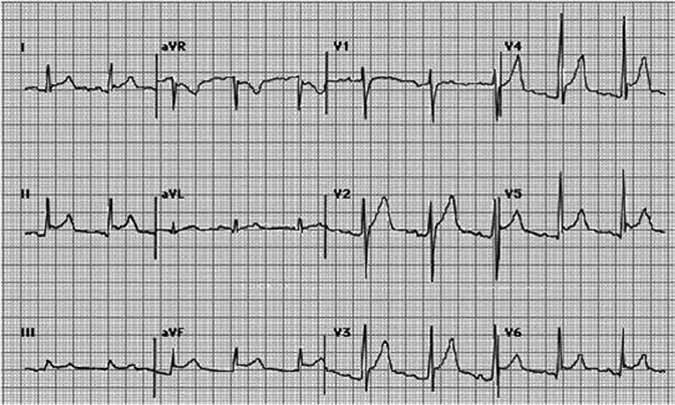 CorrectIncorrect
CorrectIncorrect -
Question 12 of 51
12. Question
Beta blockers are contraindicated in all of the following conditions except
CorrectIncorrect -
Question 13 of 51
13. Question
Which of the following is the most important risk factor of aortic aneurysm?
CorrectIncorrect -
Question 14 of 51
14. Question
A 45-year-old woman presents with ongoing chest pain. Her is BP 140/80 mmHg, heart rate 90 bpm, and saturations 99% on room air. What should you do next?
CorrectIncorrect -
Question 15 of 51
15. Question
The figure below was obtained during angiography of a patient who had redo coronary artery bypass grafting in 1987. He had 3 grafts and has a recurrence of angina. Interpret the figure below
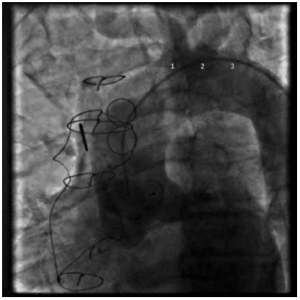 CorrectIncorrect
CorrectIncorrect -
Question 16 of 51
16. Question
A 51-year-old man came to the hospital with complaints of fatigue and cough. He had a chest X-ray as shown below. What does his chest X-ray show?
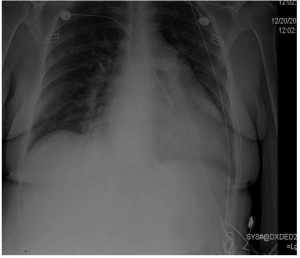 CorrectIncorrect
CorrectIncorrect -
Question 17 of 51
17. Question
A 51-year-old man came to the hospital with complaints of fatigue and cough. He had a chest X-ray as shown below. The patient also then had an echocardiogram showing mild tricuspid regurgitation, velocity of 4.7 m/s, elevated right atrial pressure of 20 mmHg, and estimated pulmonary artery systolic pressure of 110 mmHg. What are these findings suggestive of?
 CorrectIncorrect
CorrectIncorrect -
Question 18 of 51
18. Question
Verapamil is the first choice for which SVT?
CorrectIncorrect -
Question 19 of 51
19. Question
The ECG shown below is diagnostic of which of the following?
 CorrectIncorrect
CorrectIncorrect -
Question 20 of 51
20. Question
A 26-year-old patient came with palpitations and chest pain. His blood pressure is 80/60 mmHg. His ECG result is shown in the figure below. What should the initial management be?
 CorrectIncorrect
CorrectIncorrect -
Question 21 of 51
21. Question
A 27-year-old man came with sharp central chest pain and palpitations after drinking three cans of energy drink. The symptoms were ongoing when he initially attended the ED, and an ECG showed a sinus tachycardia with no ST change. The pain subsided shortly afterwards. He is normally fit and well. His father recently had a myocardial infarction at the age of 62. All observations and examination are normal. Troponin and D-dimer tests were negative. What would you recommend?
CorrectIncorrect -
Question 22 of 51
22. Question
A 59-year-old Pakistani male presented to the ER with complaints of headache. He had a computed tomography (CT) scan of his head, which showed evidence of subdural hemorrhage. He also had a chest X-ray (figure shown below) in the ER. What does the X-ray show?
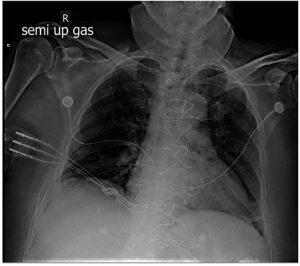 CorrectIncorrect
CorrectIncorrect -
Question 23 of 51
23. Question
A 59-year-old man with long-standing hypertension came to the clinic. He complains of some breathlessness that does not limit his physical activity. He has no other comorbidities. A transthoracic echocardiogram demonstrates aortic root dilatation and severe aortic regurgitation. Which one of the following is not an indication for surgery?
CorrectIncorrect -
Question 24 of 51
24. Question
Potassium sparing diuretics acts at
CorrectIncorrect -
Question 25 of 51
25. Question
Which of the following inotropic agent increases SVR?
CorrectIncorrect -
Question 26 of 51
26. Question
An echocardiogram of a 82-year-old woman showed both severe aortic stenosis and severe mitral regurgitation. The wrong statement regarding patients with combined or multiple valve lesions is:
CorrectIncorrect -
Question 27 of 51
27. Question
The drug of choice for patients with paroxysmal SVT is
CorrectIncorrect -
Question 28 of 51
28. Question
Which one of the following is not a contraindication to an ACE inhibitor?
CorrectIncorrect -
Question 29 of 51
29. Question
Which of the following drug is indicated in asymptomatic LV dysfunction?
CorrectIncorrect -
Question 30 of 51
30. Question
Which Calcium channel blocker below that maximally increases digoxin level?
CorrectIncorrect -
Question 31 of 51
31. Question
Which of the following ECG finding that strongly suggests congestive cardiomyopathy?
CorrectIncorrect -
Question 32 of 51
32. Question
In the evaluation of a patient with chest pain and right bundle branch (RBBB) on ECG, which of the following is true regarding exercise stress testing?
CorrectIncorrect -
Question 33 of 51
33. Question
Burgada syndrome is charactherized by which of the following
CorrectIncorrect -
Question 34 of 51
34. Question
A 55-year-old man with diabetes and prior myocardial infarction with a right coronary artery (RCA) stent presented with chest pain. His cardiac markers were normal and EF on echo was 45% with inferior wall hypokinesis. The results of a stress Sestamibi scan are shown below. What would you recommend?
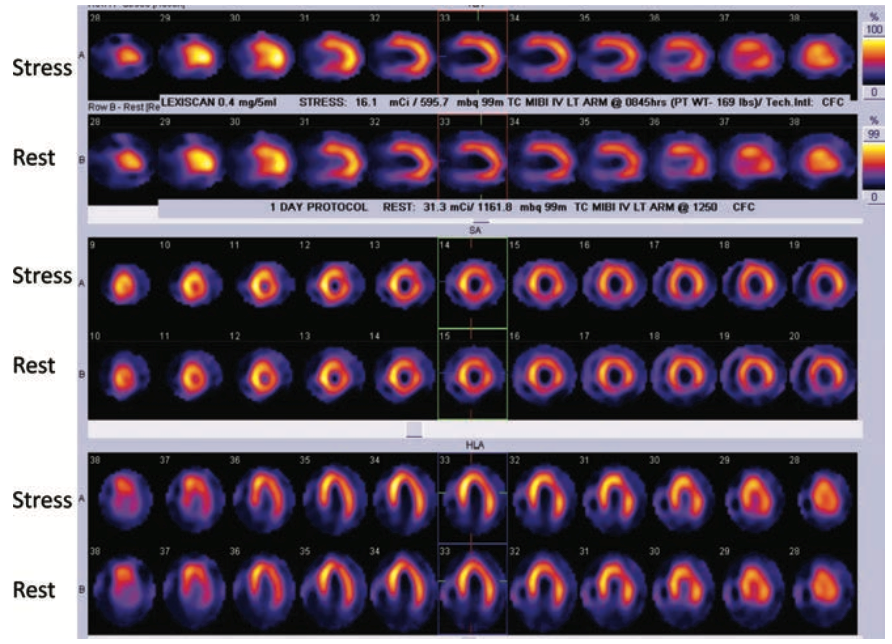 CorrectIncorrect
CorrectIncorrect -
Question 35 of 51
35. Question
A 52-year-old patient presents with breathlessness. He had hypertension for many years and has been non-compliant with his medication. His echocardiogram demonstrates an EF of 70%, with marked concentric hypertrophy. Which one of the following therapies is not appropriate?
CorrectIncorrect -
Question 36 of 51
36. Question
A 63-year-old man with known pulmonary fibrosis was admitted with an infection. He is not responding to broad-spectrum antibiotic therapy. He is a lifelong smoker. ECG demonstrated 1st degree AV block with complete RBBB and a normal QRS axis. His CXR is of poor quality but could be consistent with fluid overload. Echocardiography demonstrates thinning of the septum and apex with overall moderate impairment of systolic function. Which one of the following investigations is least likely to help with the underlying diagnosis?
CorrectIncorrect -
Question 37 of 51
37. Question
The vasodilator stress study shown in figure below is indicative of what?
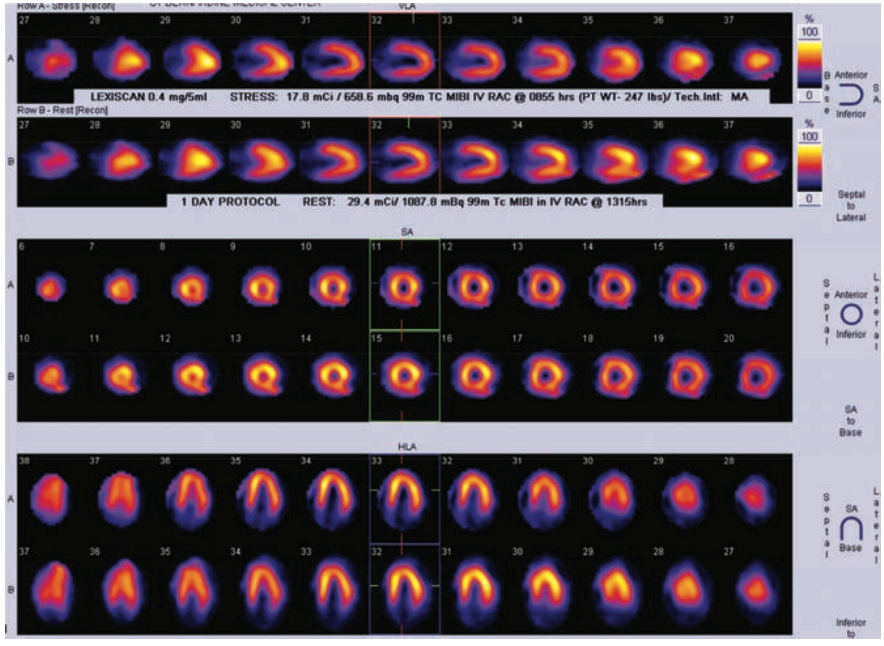 CorrectIncorrect
CorrectIncorrect -
Question 38 of 51
38. Question
A 74-year-old woman presents to your hospital with a VF arrest. She is successfully resuscitated and a subsequent ECG demonstrates a clear-cut anterior myocardial infarction with >2 mm St elevation in leads V2–V6. Coronary angiography demonstrates a suboccluded proximal LAD, with a small unobstructed circumflex artery and a 70% stenosis in the proximal RCA. She undergoes successful coronary intervention to her proximal LAD and has an uncomplicated recovery from her infarct. Her echocardiogram demonstrates akinesia of the apex, but an overall EF estimated at 35–40%. She is established on dual anti-platelet therapy, ramipril, bisoprolol, and a statin. What other therapy should she have?
CorrectIncorrect -
Question 39 of 51
39. Question
The following ion that has the highest concentration in cardiac ventricle?
CorrectIncorrect -
Question 40 of 51
40. Question
External cardiac massage is usually done in
CorrectIncorrect -
Question 41 of 51
41. Question
Diuretics has one of the following properties
CorrectIncorrect -
Question 42 of 51
42. Question
Which of the following below is not the properties of ACE inhibitors?
CorrectIncorrect -
Question 43 of 51
43. Question
A 48 hours post anterior STEMi patient who was successfully treated with primary angioplasty came to your ward. He has type 2 DM and hypertension. He is gradually improving, having initially suffered with heart failure. He still feels chest pain and auscultation reveals minimal basal crepitations. Echocardiography revealed an ejection fraction of 40%. BP is 110/70 mmHg, HR 55 bpm at rest. Ramipril has been titrated to 2.5 mg bd with bisoprolol 2.5mg od. U&Es have remained normal. How would you improve his medical treatment?
CorrectIncorrect -
Question 44 of 51
44. Question
A 59-year-old man with a bicuspid aortic valve and a history of benign prostatic hypertrophy presents with fever and lethargy. These symptoms have been present for 1 week. He had been with oral antibiotics for a urinary tract infection a week prior to admission. On examination, an ejection systolic murmur was audible on auscultation. Routine bloods and blood and urine cultures were taken. His urine culture has grown Escherichia coli. The admitting team suspects endocarditis. What is the next step of management?
CorrectIncorrect -
Question 45 of 51
45. Question
Atrial fibrillation is usually seen in all of the following patients except
CorrectIncorrect -
Question 46 of 51
46. Question
An asymptomatic 30-year-old man came for a routine medical check-up. His ECG result was shown in the figure below. What is the interpretation of this ECG?
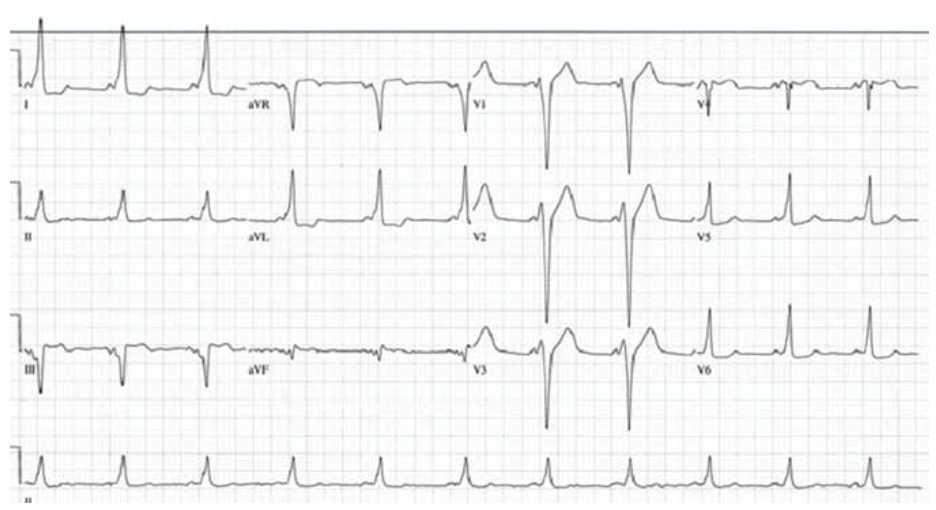 CorrectIncorrect
CorrectIncorrect -
Question 47 of 51
47. Question
The figure below showed which of the following rhythm?
 CorrectIncorrect
CorrectIncorrect -
Question 48 of 51
48. Question
One of your patients has small vessel coronary disease which is not suitable for revascularization. They are still experiencing class 2 angina particularly in the evening despite bisoprolol 0 mg od. Blood pressure is 35/90 mmHg. What would you recommend next?
CorrectIncorrect -
Question 49 of 51
49. Question
A 35-year-old man came with acute heart failure. He has a 2-week history of progressive breathlessness. He has history of type II diabetes mellitus. Echocardiogram shows an EF of 25% with anterior, septal, and lateral wall motion defects. He is stabilized on medication with furosemide, spironolactone, bisoprolol, and ramipril. What would be your next course of investigation?
CorrectIncorrect -
Question 50 of 51
50. Question
A 38-year-old iV drug abuser presents with a -week history of malaise, fatigue, and rigors. His temperature on admission was 38.5°C. examination revealed a pan-systolic murmur which was loudest at the left sternal edge. Three sets of blood cultures were taken. Transthoracic echocardiography (TTe) showed vegetation on the tricuspid valve with moderate TR. Which one of the following organisms is most likely to be positive in blood cultures?
CorrectIncorrect -
Question 51 of 51
51. Question
A 25-year-old man presents to the ED with a broad complex tachycardia that is irregularly irregular. The patient is haemodynamically uncompromised. An anaesthetist is not available to assist with immediate DC cardioversion. What is the best initial treatment option?
CorrectIncorrect
